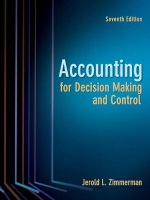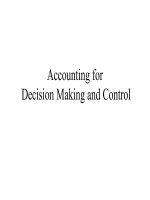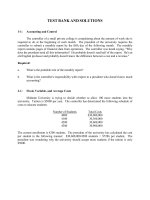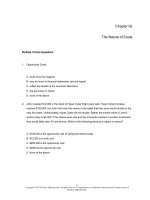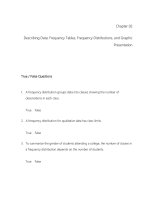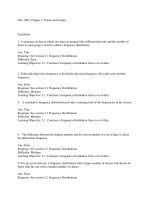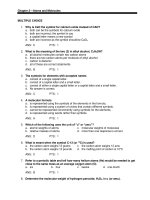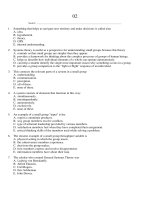Accounting for decision making and control 8th edition zimmerman test bank
Bạn đang xem bản rút gọn của tài liệu. Xem và tải ngay bản đầy đủ của tài liệu tại đây (499.85 KB, 12 trang )
TEST BANK AND SOLUTIONS
1-1:
Accounting and Control
The controller of a small private college is complaining about the amount of work she is
required to do at the beginning of each month. The president of the university requires the
controller to submit a monthly report by the fifth day of the following month. The monthly
report contains pages of financial data from operations. The controller was heard saying, "Why
does the president need all this information? He probably doesn't read half of the report. He's an
old English professor and probably doesn't know the difference between a cost and a revenue."
Required:
a.
What is the probable role of the monthly report?
b.
What is the controller's responsibility with respect to a president who doesn't know much
accounting?
2-1:
Fixed, Variable, and Average Costs
Midstate University is trying to decide whether to allow 100 more students into the
university. Tuition is $5000 per year. The controller has determined the following schedule of
costs to educate students:
Number of Students
4000
4100
4200
4300
Total Costs
$30,000,000
30,300,000
30,600,000
30,900,000
The current enrollment is 4200 students. The president of the university has calculated the cost
per student in the following manner: $30,600,000/4200 students = $7286 per student. The
president was wondering why the university should accept more students if the tuition is only
$5000.
Required:
a.
What is wrong with the president's calculation?
b.
What are the fixed and variable costs of operating the university?
2-2:
The Elements of Cost Volume Profit
The M Company’s variable costs are 75% of the sales price per unit and their fixed costs
are $240,000. If the company earned $60,000 in selling 150,000 units, what was the sales price
per unit?
2-3:
Opportunity Costs
The First Church has been asked to operate a homeless shelter in part of the church. To
operate a homeless shelter the church would have to hire a full time employee for $1,200/month
to manage the shelter. In addition, the church would have to purchase $400 of supplies/month
for the people using the shelter. The space that would be used by the shelter is rented for
wedding parties. The church averages about 5 wedding parties a month that pay rent of $200 per
party. Utilities are normally $1,000 per month. With the homeless shelter, the utilities will
increase to $1,300 per month.
What is the opportunity cost to the church of operating a homeless shelter in the church?
2-4:
Fixed and Variable Costs
The university athletic department has been asked to host a professional basketball game
at the campus sports center. The athletic director must estimate the opportunity cost of holding
the event at the sports center. The only other event scheduled for the sports center that evening
is a fencing match that would not have generated any additional costs or revenues. The fencing
match can be held at the local high school, but the rental cost of the high school gym would be
$200. The athletic director estimates that the professional basketball game will require 20 hours
of labor to prepare the building. Clean-up depends on the number of spectators. The athletic
director estimates the time of clean-up to be equal to 2 minutes per spectator. The labor would
be hired especially for the basketball game and would cost $8 per hour. Utilities will be $500
greater if the basketball game is held at the sports center. All other costs would be covered by
the professional basketball team.
Required:
a.
What is the variable cost of having one more spectator?
b.
What is the opportunity cost of allowing the professional basketball team to use the sports
center if 10,000 spectators are expected?
c.
What is the opportunity cost of allowing the professional basketball team to use the sports
center if 12,000 spectators are expected?
2-5:
Opportunity Cost of Attracting Industry
The Itagi Computer Company From Japan is looking to build a factory for making DVD
burners in the United States. The company is concerned about the safety and well-being of its
employees and wants to locate in a community with good schools. The company also wants the
factory to be profitable and is looking for subsidies from potential communities. Encouraging
new business to create jobs for citizens is important for communities, especially communities
with high unemployment.
Wellville has not been very well since the shoe factory left town. The city officials have
been working on a deal with Itagi to get the company to locate in Wellville. Itagi officials have
identified a 20 acre undeveloped site. The city has tentatively agreed to buy the site for $50,000
for Itagi and not require any payment of property taxes on the factory by Itagi for the first five
years of operation. The property tax deal will save Itagi $3,000,000 in taxes over the five years.
This deal was leaked to the local newspaper. The headlines the next day were: "Wellville Gives
Away $3,000,000+ to Japanese Company".
Required:
a.
Do the headlines accurately describe the deal with Itagi?
b.
What are the relevant costs and benefits to the citizens of Wellville of making this deal?
2-6:
Cost, Volume, Profit Analysis
With the possibility of the US Congress relaxing restrictions on cutting old growth, a
local lumber company is considering an expansion of its facilities. The company believes it can
sell lumber for $0.18/board foot. A board foot is a measure of lumber. The tax rate for the
company is 30 percent. The company has the following two opportunities:
•
Build Factory A with annual fixed costs of $20 million and variable costs of
$0.10/board foot. This factory has an annual capacity of 500 million board feet.
•
Build Factory B with annual fixed costs of $10 million and variable costs of
$0.12/board foot. This factory has an annual capacity of 300 million board feet.
Required:
a.
What is the break-even point in board feet for Factory A?
b.
If the company wants to generate an after tax profit of $2 million with Factory B, how
many board feet would the company have to process and sell?
c.
If demand for lumber is uncertain, which factory is riskier?
d.
At what level of board feet would the after-tax profit of the two factories be the same?
2-7:
Cost, Volume, Profit Analysis
Leslie Mittelberg is considering the wholesaling of a leather handbag from Kenya. She
must travel to Kenya to check on quality and transportation. The trip will cost $3000. The cost
of the handbag is $10 and shipping to the United States can occur through the postal system for
$2 per handbag or through a freight company which will ship a container that can hold up to a
1000 handbags at a cost of $1000. The freight company will charge $1000 even if less than
1000 handbags are shipped. Leslie will try to sell the handbags to retailers for $20. Assume
there are no other costs and benefits.
Required:
a.
What is the break-even point if shipping is through the postal system?
b.
How many units must be sold if Leslie uses the freight company and she wants to have a
profit of $1000?
c.
At what output level would the two shipping methods yield the same profit?
d.
Suppose a large discount store asks to buy an additional 1000 handbags beyond normal
sales. Which shipping method should be used and what is the minimum sales price
Leslie should consider in selling those 1000 handbags?
2-8: Multiple Product Cost Volume Profit
A company sells three products as shown below:
Units
Sales
Variable Costs
Contribution
Margin
Fixed Costs
Product X
60,000
$90,000
$63,000
Product Y
140,000
$150,000
$93,000
Product Z
50,000
$60,000
$19,000
Total
250,000
$300,000
$175,000
$125,000
$100,000
Required:
a.
How many units of each product need to be sold to breakeven?
b.
How many units must of each product must be sold if the company wants to have a profit
of $50,000?
2-9: Make Buy
A company has needs 10,000 units of a component used in producing one of its products.
The latest internal accounting reports show that the per unit manufacturing cost to be $150.00.
The manufacturing cost per component broken down into type of costs is as follows: Variable
manufacturing costs = $110.00 and fixed manufacturing overhead = $40. The company recently
received an offer from another manufacturer to produce the component for $144.00. If they buy
the component on the outside 40% of the fixed overhead can be avoided.
Required:
a.
If the company decides to have the component made by the outside supplier at $144.00,
what is the impact on income?
b.
What price would make the company indifferent between making the component
internally and having the outside supplier make it?
2-10: Cost, Volume, Profit Analysis
Kalifo Company manufactures a line of electric garden tools that are sold in general
hardware stores. The company's controller, Sylvia Harlow, has just received the sales forecast
for the coming year for Kalifo's three products: weeders, hedge clippers, and leaf blowers.
Kalifo has experienced considerable variations in sales volumes and variable costs over the past
two years, and Harlow believes the forecast should be carefully evaluated from a cost-volumeprofit viewpoint. The preliminary budget information for 1996 is presented below.
Unit sales
Unit selling price
Variable manufacturing cost per unit
Variable selling cost per unit
Weeders
50,000
$28.00
13.00
5.00
Hedge Clippers
50,000
$36.00
12.00
4.00
Leaf
Blowers
100,000
$48.00
25.00
6.00
For 1996, Kalifo's fixed factory overhead is budgeted at $2 million, and the company's
fixed selling and administrative expenses are forecast to be $600,000. Kalifo has a tax rate of 40
percent.
Required:
a.
Determine Kalifo Co.'s budgeted net income for 1996.
b.
Assuming that the sales mix remains as budgeted, determine how many units of each
product Kalifo must sell in order to break even in 1996.
c.
Determine the total dollar sales Kalifo must sell in 1996 in order to earn an after-tax net
income of $450,000.
d.
After preparing the original estimates, Kalifo determines that its variable manufacturing
cost of leaf blowers will increase 20 percent and the variable selling cost of hedge
clippers can be expected to increase $1 per unit. However, Kalifo has decided not to
change the selling price of either product. In addition, Kalifo learns that its leaf blower is
perceived as the best value on the market, and it can expect to sell three times as many
leaf blowers as any other product. Under these circumstances, determine how many units
of each product Kalifo will have to sell to break even in 1996.
e.
Explain the limitations of cost-volume-profit analysis that Sylvia Harlow should consider
when evaluating Kalifo's 1996 budget.
Source: CMA adapted.
2-11: Breakeven and Cost-Volume-Profit with Taxes
DisKing Company is a retailer for video disks. The projected after-tax net income for the
current year is $120,000 based on a sales volume of 200,000 video disks. DisKing has been
selling the disks at $16 each. The variable costs consist of the $10 unit purchase price of the
disks and a handling cost of $2 per disk. DisKing’s annual fixed costs are $600,000 and DisKing
is subject to a 40 percent income tax rate.
Management is planning for the coming year, when it expects that the unit purchase price
of the video disks will increase 30 percent.
Required:
a.
Calculate DisKing Company’s break-even point for the current year in number of video
disks.
b.
Calculate the increased after-tax income for the current year from an increase of 10
percent in projected unit sales volume.
c.
If the unit selling price remains at $16, calculate the volume of sales in dollars that
DisKing Company must achieve in the coming year to maintain the same after-tax net
income as projected for the current year.
Source: CMA adapted
2-12: Cost-volume-profit of a Make/buy Decision
Elly Industries is a multiproduct company that currently manufactures 30,000 units of
Part MR24 each month for use in production. The facilities now being used to produce Part
MR24 have affixed monthly cost of $150,000 and a capacity to produce 84,000 units per month.
If Elly were to buy Part MR24 from an outside supplier, the facilities would be idle, but its fixed
costs would continue at 40 percent of its present amount. The variable production costs of Part
MR24 are $11 per unit.
Required:
a.
If Elly Industries continues to use 30,000 units of Part MR24 each month, it would
realize a net benefit by purchasing Part MR24 from an outside supplier only if the
supplier’s unit price is less than how much?
b.
If Elly Industries can obtain Part MR24 from an outside supplier at a unit purchase price
of $12.875, what is the monthly usage at which it will be indifferent between purchasing
and making Part MR24?
Source: CMA adapted
2-13: Opportunity Cost of Purchase Discounts and Lost Sales
Winter Company is a medium-size manufacturer of hard drives that are sold to computer
manufacturers. At the beginning of 2012 Winter began shipping a much-improved hard drive,
Model W899. The W899 was an immediate success and accounted for $5 million in revenues
for Winter in 2012.
While the W899 was in the development stage, Winter planned to price it at $130. In
preliminary discussions with customers about the W899 design, no resistance was detected to
suggestions that the price might be $130. The $130 price was considerably higher than the
estimated variable cost of $70 per unit to produce the W899, and it would provide Winter with
ample profits.
Shortly before setting the price of the W899, Winter discovered that a competitor was
reading a product very similar to the W899 and was no more than 60 days behind Winter’s own
schedule. No information could be obtained on the competitor’s planned price, although it had a
reputation for aggressive pricing. Worried about the competitor, and unsure of the market size,
Winter lowered the price of the W899 to $100. It maintained the price although, to Winter’s
surprise, the competitor announced a price of $130 for its product.
After reviewing the 2012 sales of the W899, Winter’s management concluded that unit
sales would have been the same if the product had been marketed at the original price of $130
each. Management has predicted that 2013 sales of the W899 would be either 85,000 units at
$100 each or 60,000 units at $130 each. Winter has decided to raise the price of the disk drive to
$130 effective immediately.
Having supported the higher price from the beginning, Sharon Daley, Winter’s marketing
director, believes that the opportunity cost of selling the W899 for $100 during 2012 should be
reflected in the company’s internal records and reports. In support of her recommendation,
Daley explained that the company has booked these types of costs on other occasions when
purchase discounts not taken for early payment have been recorded.
Required:
a.
Define opportunity cost and explain why opportunity costs are not usually recorded.
b.
What is the 2012 opportunity cost?
c.
Explain the impact of Winter Company’s selection of the $130 selling price for the W899
on 2013 operating income. Support your answer with appropriate calculations.
Source: CMA adapted
2-14: Make/Buy and the Opportunity Cost of Freed Capacity
Leland Manufacturing uses 10 units of part KJ37 each month in the production of radar
equipment. The cost to manufacture one unit of KJ37 is presented in the accompanying table.
Direct materials
Materials handling (20% of direct material cost)
Direct labor
Manufacturing overhead
Total manufacturing cost
$ 1,000
200
8,000
12,000
$21,200
Materials handling represents the direct variable costs of the receiving department and is applied
to direct materials and purchased components on the basis of their cost. This is a separate charge
in addition to manufacturing overhead. Leland’s annual manufacturing overhead budget is onethird variable and two-third fixed. Scott Supply, one of Leland’s reliable vendors, has offered to
supply part KJ37 at a unit price of $15,000. The fixed cost of producing KJ37 is the cost of a
special piece of testing equipment that ensures the quality of each part manufactured. This
testing equipment is under a long-term, noncancelable lease. If Leland were to purchase part
KJ37, materials handling costs would not be incurred.
Required:
a.
If Leland purchases the KJ37 units from Scott, the capacity Leland was using to
manufacture these parts would be idle. Should Leland purchase the parts from Scott?
Make explicit any key assumptions.
b.
Assume Leland Manufacturing is able to rent all idle capacity for $25,000 per month.
Should Leland purchase from Scott Supply? Make explicit any key assumptions.
c.
Assume that Leland Manufacturing does not wish to commit to a rental agreement but
could use idle capacity to manufacture another product that would contribute $52,000 per
month. Should Leland manufacture KJ37? Make explicit any key assumptions.
Source: CMA adapted
3-1:
Annuity
Suppose the opportunity cost of capital is 10 percent and you have just won a $1 million
lottery that entitles you to $100,000 at the end of each of the next ten years.
Required:
a.
What is the minimum lump sum cash payment you would be willing to take now in lieu
of the ten-year annuity?
b.
What is the minimum lump sum you would be willing to accept at the end of the ten
years in lieu of the annuity?
c.
Suppose three years have passed and you have just received the third payment and you
have seven left when the lottery promoters approach you with an offer to “settle-up for
cash.” What is the minimum you would accept (the end of year three)?
d.
How would your answer to part (a) change if the first payment came immediately (at t =
0) and the remaining payments were at the beginning instead of at the end of each year?
3-2:
Identifying the Opportunity Cost of Capital
Don Phelps recently started a dry cleaning business. He would like to expand the
business and have a coin-operated laundry also. The expansion of the building and the washing
and drying machines will cost $100,000. The bank will lend the business $100,000 at 12 percent
interest rate. Don could get a 10 percent interest rate loan if he uses his personal house as
collateral. The lower interest rate reflects the increased security of the loan to the bank, because
the bank could take Don's home if he doesn't pay back the loan. Don currently can put money in
the bank and receive 6 percent interest.
Required:
Provide arguments for using 12 percent, 10 percent, and 6 percent as the opportunity cost
of capital for evaluating the investment.
3-3:
Financing Charges and Net Present Value
The president of the company is not convinced that the interest expense should be
excluded from the calculation of the net present value. He points out that, "Interest is a cash
flow. You are supposed to discount cash flows. We borrowed money to completely finance this
project. Why not discount interest expenditures?" The president is so convinced that he asks
you, the controller, to calculate the net present value including the interest expense.
How can you adjust the net present value analysis to compensate for the inclusion of the
interest expense?
3-4:
Asset Replacement
The Baltic Company is considering the purchase of a new machine tool to replace an
obsolete one. The machine being used for the operation has a tax book value of $80,000, with an
annual depreciation expense of $8,000. It has a salvage value (resale value) of $40,000, is in
good working order, and will last, physically, for at least 10 more years. The proposed machine
will perform the operation so much more efficiently that Baltic engineers estimate that labor,
material, and other direct costs of the operation will be reduced $60,000 a year if it is installed.
The proposed machine costs $240,000 delivered and installed, and its economic life is estimated
at 10 years, with zero salvage value. The company expects to earn 14 percent on its investment
after taxes (14 percent is the firm's cost of capital). The tax rate is 40 percent, and the firm uses
straight-line depreciation. Any gain or loss on the machine is subject to tax at 40 percent.
Should Baltic buy the new machine?
4-1:
Choosing Performance Measures
Jen and Barry opened an ice cream shop in Eugene. It was a big success, so they decide
to open a ice cream shops in many cities including Portland. They hire Dante to manage the
shop in Portland. Jen and Barry are considering two different sets of performance measures for
Dante. The first set would grade Dante based on the cleanliness of the restaurant and customer
service. The second set would use accounting numbers including the profit of the shop in
Portland.
What are the advantages and disadvantages of each set of performance measures?
4-2:
Linking Decision Rights and Knowledge
Professional football teams have both a coach and a general manager. The general
manager is usually responsible for the general operations of the organization and maintains the
decision rights for selecting personnel on the football team. The coach is responsible for the
training of the football team and making decisions on game day. Many coaches have been
unhappy with their relationship with the general manager and feel they should have more
decision rights in choosing the players on the team. Some of the top coaches are now insisting
on also being general managers.
What are the advantages and disadvantages of separating the duties of the coach and
general manager with respect to selecting members of the football team?
4-3:
Monitoring Computer Use
Samson Company is an engineering firm. Many of the employees are engineers who are
working individually on different projects. Most of the design work takes place on computers.
The computers are connected by a network and employees can also "surf" the internet through
their desk top computers.
The president is concerned about productivity among his engineers. He has acquired
software that allows him to monitor each engineer's computer work. At anytime during the day,
the president can observe on her screen exactly what the different engineers are working on. The
engineers are quite unhappy with this monitoring process. They feel it is unethical for the
president to be able to access what they are working on without their knowledge.
Describe the pros and cons of monitoring through observing the computer work of the
engineers.
4-4:
Choosing Performance Measures
The president of the Canby Insurance Company has just read an article on the balanced
scorecard. A company has a balanced scorecard when there is a set of performance measures
that reflect the diverse interests and goals of all the stakeholders (shareholders, customers,
employees, and society) of the organization. Presently, Canby Insurance Company has only one
performance measure for the top executives: profit. The board of directors claims that profit as
the sole performance measure is sufficient. If customers are satisfied and employees are
productive, then the company will be profitable. Any other performance measure will detract
from the basic goal of making a profit.
Required:
